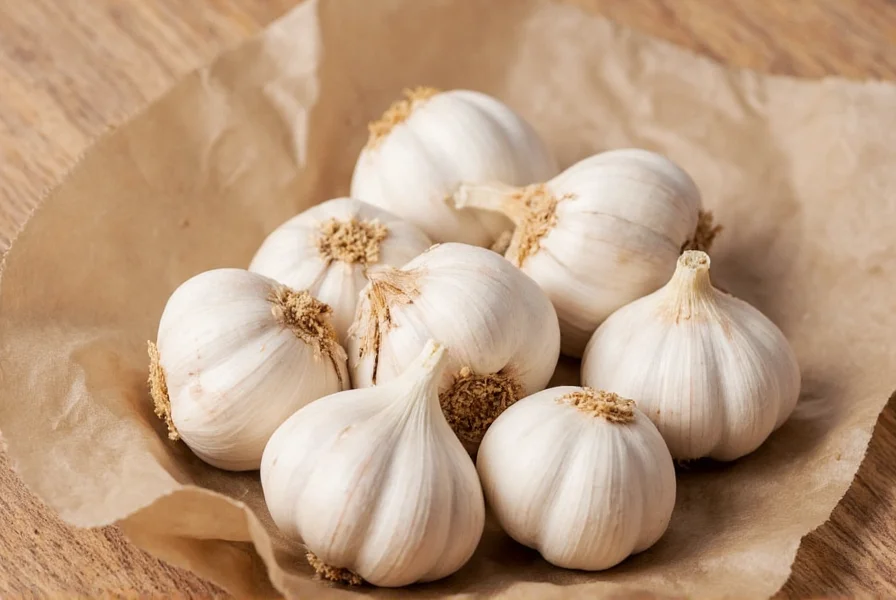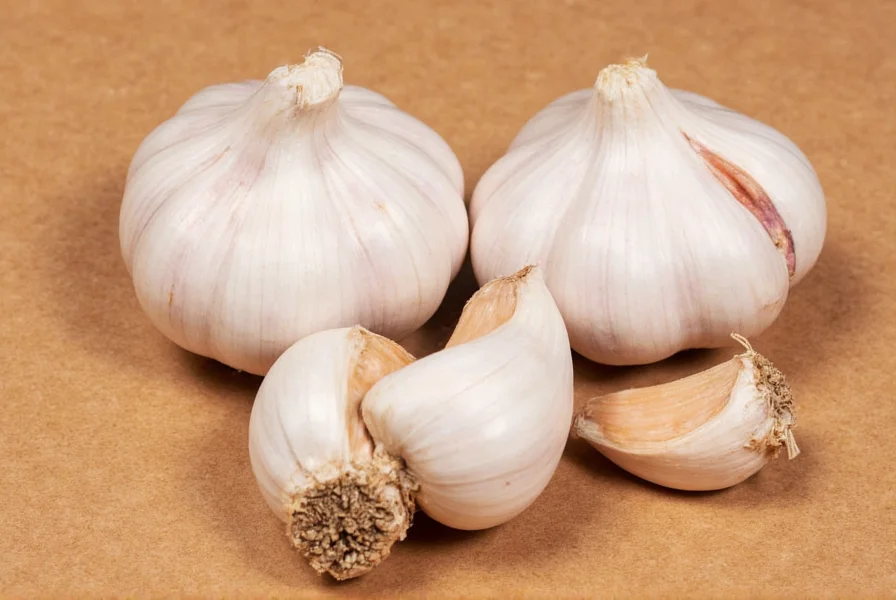Garlic is a kitchen staple worldwide, but like all fresh produce, it has a limited shelf life. Understanding how to identify spoiled garlic and properly store it ensures you get the most flavor and safety from this versatile ingredient. This guide covers everything you need to know about garlic freshness, spoilage indicators, and optimal storage practices.
How to Identify Spoiled Garlic Cloves
Recognizing when garlic has gone bad is crucial for both flavor quality and food safety. Here are the key indicators to watch for:
Visual Signs of Bad Garlic
- Mold growth - Visible fuzzy spots in white, green, or black
- Discoloration - Yellow or brown spots instead of pure white
- Soft or mushy areas - Firm garlic should feel solid throughout
- Excessive sprouting - While minor sprouting is normal, extensive green growth indicates aging
Texture and Smell Indicators
Garlic that has gone bad often shows clear textural changes. Properly stored garlic should feel firm and dry to the touch. If cloves feel soft, rubbery, or damp, they're likely spoiling. The smell test is equally important - fresh garlic has a characteristic pungent aroma, while spoiled garlic develops a sour, unpleasant odor or loses its distinctive scent entirely.
| Condition | Still Safe? | Recommended Action |
|---|---|---|
| Minor sprouting (small green shoot) | Yes | Remove sprout and use garlic |
| Small soft spot | Yes | Cut away affected area and use immediately |
| Mold growth | No | Discard entire bulb (mold spreads internally) |
| Completely soft or mushy | No | Discard immediately |
| Sour or unpleasant odor | No | Discard immediately |
Garlic Shelf Life: How Long Do Garlic Cloves Last?
The longevity of garlic depends significantly on storage conditions and whether the bulb is whole or separated into cloves. Understanding these timelines helps prevent waste and ensures optimal flavor.
Storage Duration by Method
Whole garlic bulbs maintain freshness much longer than individual cloves. Once separated, garlic begins deteriorating more rapidly. The following table shows typical shelf life under various storage conditions:
| Storage Method | Whole Bulb | Individual Cloves | Min. Temperature | Max. Humidity |
|---|---|---|---|---|
| Pantry (mesh bag) | 3-6 months | 7-10 days | 60-65°F (15-18°C) | 60-70% |
| Refrigerator (crisper drawer) | 1-2 months | 1-2 weeks | 32-40°F (0-4°C) | 85-90% |
| Freezer (whole cloves) | N/A | 10-12 months | 0°F (-18°C) | 10-15% |
| Oil preservation | N/A | 3-4 months | 32-40°F (0-4°C) | N/A |
Optimal Garlic Storage Techniques
Proper storage dramatically extends garlic's shelf life while maintaining flavor quality. The key is creating conditions that minimize moisture and prevent premature sprouting.
Room Temperature Storage (Best Method)
The ideal environment for storing whole garlic bulbs is a cool, dark, dry place with good air circulation. A pantry or kitchen cabinet works well, but avoid areas near heat sources like stoves or dishwashers. Never store garlic in the refrigerator unless it's already peeled or cut, as the humidity promotes mold growth.
Use breathable containers like mesh bags, paper bags with ventilation holes, or traditional garlic keepers with open designs. Avoid plastic bags or airtight containers, which trap moisture and accelerate spoilage. The optimal temperature range is 60-65°F (15-18°C) with humidity around 60-70%.
Refrigeration and Freezing Options
Refrigeration works best for already-peeled cloves or cut garlic. Store in an airtight container in the crisper drawer for up to 2 weeks. For longer storage, freezing is excellent - simply place peeled cloves in a freezer bag with air removed. Frozen garlic maintains quality for 10-12 months and can be used directly from frozen in cooked dishes.
Health Considerations: Risks of Consuming Bad Garlic
Eating spoiled garlic poses potential health risks beyond just unpleasant flavor. While rare, improperly stored garlic can create conditions favorable for Clostridium botulinum, the bacteria that causes botulism, especially when stored in oil at room temperature.
Moldy garlic should always be discarded completely, as mold spreads internally beyond visible areas. Garlic with soft spots or minor sprouting is generally safe if the affected areas are removed, but garlic with sour odors or extensive discoloration should be thrown away. When in doubt about garlic freshness, it's always safer to discard it than risk foodborne illness.

Creative Uses for Aging Garlic
If your garlic is beginning to sprout but shows no other signs of spoilage, don't throw it away! Sprouted garlic remains edible and can be used in several creative ways:
- Plant sprouted cloves in soil to grow green garlic shoots
- Use in soups and stews where texture matters less
- Make garlic-infused oil (store in refrigerator and use within 1 week)
- Create roasted garlic spread for bread or dips
- Dehydrate cloves for powdered garlic seasoning
FAQ: Common Questions About Garlic Freshness
Can you eat garlic that has sprouted?
Yes, sprouted garlic is safe to eat. The green sprout in the center of the clove is edible but often has a bitter taste. Simply cut it out with a knife before using the garlic. While sprouted garlic may have slightly less flavor intensity than fresh garlic, it remains perfectly safe and nutritious to consume as long as there are no other signs of spoilage like mold or soft spots.
How can you tell if garlic has gone bad?
Signs that garlic has gone bad include soft or mushy spots, visible mold (white, green, or black fuzzy growth), unpleasant sour odor, yellow or brown discoloration, and excessive sprouting. Fresh garlic should feel firm throughout, have a pure white color, and have its characteristic pungent aroma. If garlic shows multiple signs of spoilage, it should be discarded immediately.
Does refrigerated garlic last longer than pantry-stored garlic?
For whole garlic bulbs, refrigeration actually shortens shelf life compared to proper pantry storage. The high humidity in refrigerators promotes mold growth and sprouting in whole garlic. Refrigeration is only recommended for already-peeled cloves or cut garlic, which will last 1-2 weeks in the crisper drawer. Whole bulbs stored in a cool, dark pantry with good air circulation typically last 3-6 months, significantly longer than refrigerated whole bulbs which last only 1-2 months.
Can bad garlic make you sick?
Yes, consuming spoiled garlic can potentially make you sick. Garlic with mold should always be discarded completely, as mold spreads internally beyond visible areas. The greatest risk comes from garlic stored improperly in oil at room temperature, which can create conditions favorable for Clostridium botulinum bacteria that causes botulism. While rare, this serious illness can occur from improperly stored garlic. Garlic with soft spots, minor sprouting, or slight discoloration is generally safe if affected areas are removed, but garlic with sour odors or extensive spoilage should be thrown away.
What's the best way to store garlic to prevent it from going bad?
The best way to store garlic is in a cool, dark, dry place with good air circulation, ideally between 60-65°F (15-18°C) with 60-70% humidity. Use breathable containers like mesh bags, paper bags with ventilation holes, or traditional garlic keepers. Never store whole garlic in plastic bags or airtight containers, which trap moisture and accelerate spoilage. Keep garlic away from heat sources and direct sunlight. For already-peeled cloves, store in an airtight container in the refrigerator for up to 2 weeks or freeze for up to 12 months.











 浙公网安备
33010002000092号
浙公网安备
33010002000092号 浙B2-20120091-4
浙B2-20120091-4